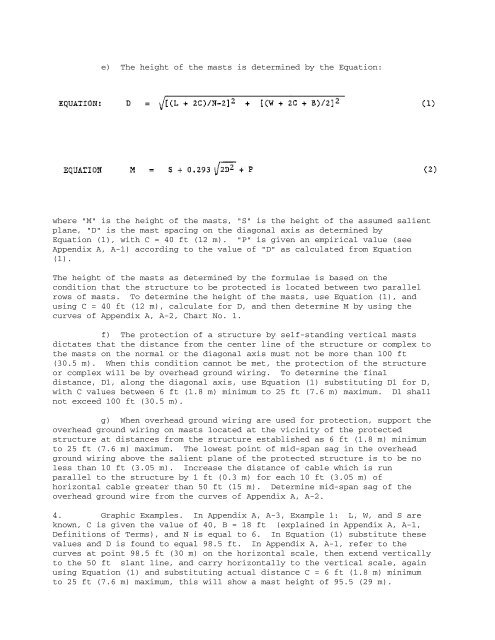NAVFAC MIL-HDBK-1004/6 Lightning Protection
NAVFAC MIL-HDBK-1004/6 Lightning Protection
NAVFAC MIL-HDBK-1004/6 Lightning Protection
Create successful ePaper yourself
Turn your PDF publications into a flip-book with our unique Google optimized e-Paper software.
e) The height of the masts is determined by the Equation:where "M" is the height of the masts, "S" is the height of the assumed salientplane, "D" is the mast spacing on the diagonal axis as determined byEquation (1), with C = 40 ft (12 m). "P" is given an empirical value (seeAppendix A, A-1) according to the value of "D" as calculated from Equation(1).The height of the masts as determined by the formulae is based on thecondition that the structure to be protected is located between two parallelrows of masts. To determine the height of the masts, use Equation (1), andusing C = 40 ft (12 m), calculate for D, and then determine M by using thecurves of Appendix A, A-2, Chart No. 1.f) The protection of a structure by self-standing vertical mastsdictates that the distance from the center line of the structure or complex tothe masts on the normal or the diagonal axis must not be more than 100 ft(30.5 m). When this condition cannot be met, the protection of the structureor complex will be by overhead ground wiring. To determine the finaldistance, D1, along the diagonal axis, use Equation (1) substituting D1 for D,with C values between 6 ft (1.8 m) minimum to 25 ft (7.6 m) maximum. D1 shallnot exceed 100 ft (30.5 m).g) When overhead ground wiring are used for protection, support theoverhead ground wiring on masts located at the vicinity of the protectedstructure at distances from the structure established as 6 ft (1.8 m) minimumto 25 ft (7.6 m) maximum. The lowest point of mid-span sag in the overheadground wiring above the salient plane of the protected structure is to be noless than 10 ft (3.05 m). Increase the distance of cable which is runparallel to the structure by 1 ft (0.3 m) for each 10 ft (3.05 m) ofhorizontal cable greater than 50 ft (15 m). Determine mid-span sag of theoverhead ground wire from the curves of Appendix A, A-2.4. Graphic Examples. In Appendix A, A-3, Example 1: L, W, and S areknown, C is given the value of 40, B = 18 ft (explained in Appendix A, A-1,Definitions of Terms), and N is equal to 6. In Equation (1) substitute thesevalues and D is found to equal 98.5 ft. In Appendix A, A-1, refer to thecurves at point 98.5 ft (30 m) on the horizontal scale, then extend verticallyto the 50 ft slant line, and carry horizontally to the vertical scale, againusing Equation (1) and substituting actual distance C = 6 ft (1.8 m) minimumto 25 ft (7.6 m) maximum, this will show a mast height of 95.5 (29 m).
















